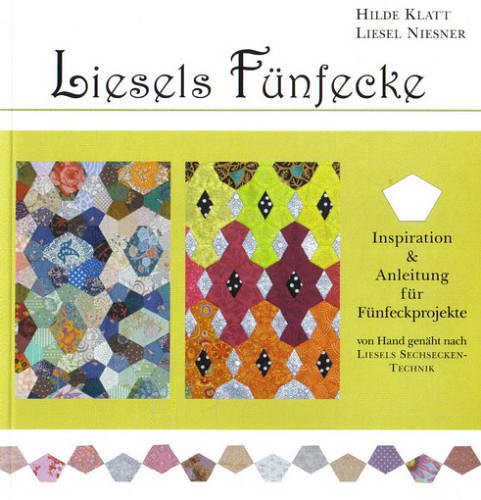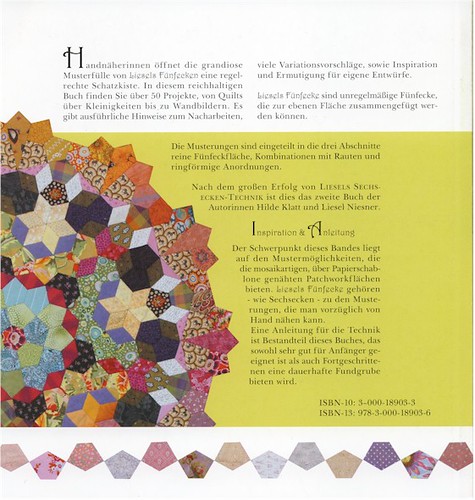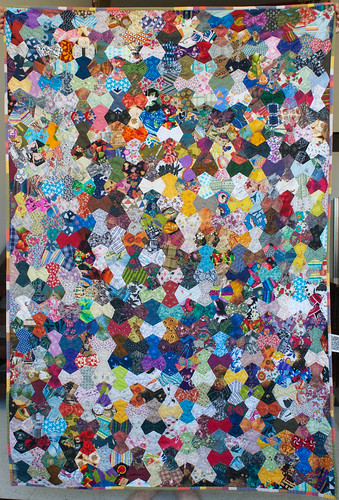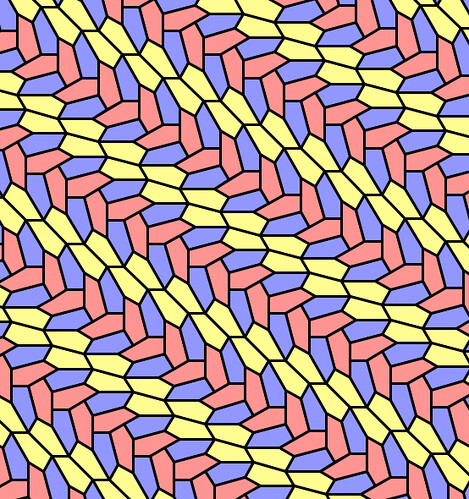New pentagon in town!
Unsurprisingly, several people reached out to me to say HEY NEW PENTAGON AMY, DID YOU SEE? I love you. You know me well.
There are two kinds of people fascinated with the idea of finding shapes that can fill a two-dimensional plane: geometry professors, and quilters. What's weird, and sad, is that they aren't really talking to each other. I've corresponded with a few of them, and as far as I can tell, there are quite a few mathematicians who are working on these problems, but the number of quilters playing with the end results likely can be numbered on my fingers and toes.
This is sad -- and fixable.
So what came out this week? It's a newly-found irregular pentagon with very specific angles (60°, 135°, 105°, 90°, 150°) that can tile the plane with no gaps. This pentagon, published by Casey Mann, Jennifer McLoud and David Von Derau, marks the 15th tilable pentagon found, and the first one found since 1985:
I don't have a way of rendering the tiling in a vector format, to get the perfect shape. However, I worked backward using the .png image that Jaap Scherphuis' Java applet created, plus the published information about the angles. I've got a shape that's likely very close. It's likely close enough for quilting; if you're curious to try it, let me know and I can try turning it into something that's printable. (I'm reachable at amy@ [this site], and let me know what size paper. If I can make it into a usable PDF file, I'll share it with you. I'll update the post if I do.)
This tiling is best suited for English paper piecing. Explaining how to do it is far past the scope of what I want to write on a perfectly good Saturday afternoon, but suffice it to say, it works very well for shapes that are irregular and don't join up into long seams. EPP makes it easy to preserve the angles of these pieces and get the accuracy you want when showing off a project like this.
If the idea of doing something odd and pentagonal has your interest, though, let me take a moment to recommend a different tiling that is more widely available. There's a book I wrote about a few years ago (2011: "Save me, interlibrary loan!") that's worth quoting here. It is only available in German, but the grids at the back of the book need no translation.
 Front cover: 'Liesels Fünfecke'
Front cover: 'Liesels Fünfecke'
 Back cover: 'Liesels Fünfecke'
Back cover: 'Liesels Fünfecke'
Title: Liesels Fünfecke, by Liesel Niesner and Hilde Klatt
ISBN: 978-3000189036
Format: Paperback
Published: 2006
(buy it at Amazon)
- English paper piecing templates are available at http://www.paperpieces.com/shop/Pentagons--Variations/Stretched-Pentagon...
- Printable grids for design ideas are available at http://evchens.de/sogehts/downloads.html (German-language, but easily navigable)
I haven't gone trawling in a few years to see if many people have made quilts from this book. When I last looked in 2011, I couldn't find any libraries in the US who had this book available for interlibrary loan, but that may have changed since then.
I've done a scrap / sampler quilt using these pentagons, which -- since I worked on it partially in Washington DC -- I had to name "Pentagon Papers" --
 Pentagon Papers, re-photographed
Pentagon Papers, re-photographed
and because I'm a Giant Nerd, the backing is from a Doctor Who duvet cover I disassembled:
Here's hoping I can help encourage a few quilters to help move English paper piecing past hexagons.




Comments
Love this. I’m always looking
Love this. I'm always looking at different shapes for epp
Your best bet is to skip the
Your best bet is to skip the quilting books and go to the geometry / tiling books instead. They also try to sell you less crap.